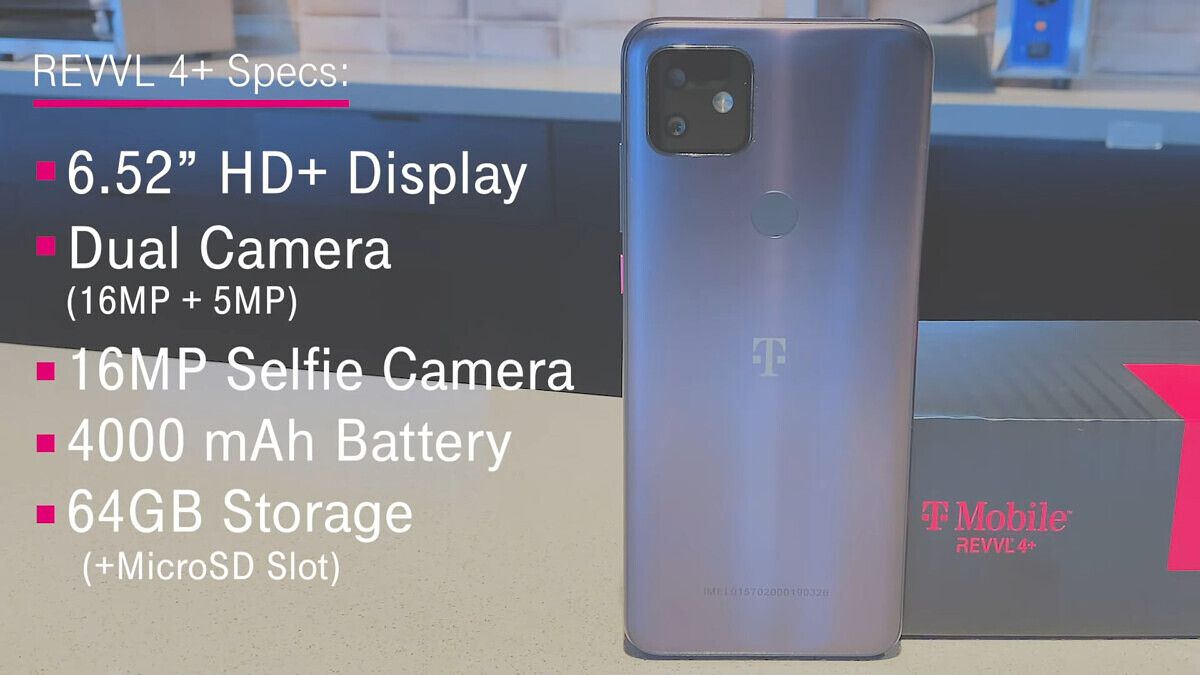T-Mobile yesterday unveiled a brand new lineup of affordable REVVL smartphones, including the REVVL 5G, the REVVL 4, and the REVVL 4+.
With many of today’s top 5G-equipped Android devices retailing for $999 or more, T-Mobile wants to offer something more accessible, so it’s offering the REVVL 5G for just $200 after 24 monthly bill credits if you switch or add a line. If you prefer, you can buy the device outright for just $399, which is comparable in price to some of today’s top mid-range handsets, including the Google Pixel 4a.
As for the REVVL 5G’s specs, it’s a decidedly mid-range affair:
REVVL 5G
- Camera: 48MP (main) + 8 MP (Super Wide) + 5MP (Macros) RFC with 16MP FFC
- Battery: 4500 mAh
- Color: Nebula Black
- OS: Android 10
- Screen: 6.53” 19:5:9 FHD+ Display
- RAM: 6GB
- ROM: 128GB
- Bands: 5G n71/n2/n66/n41/n25 LTE 2/4/66/25/26/41
- Security: Face unlock and fingerprint sensor
- Dimensions: 6.51” X 3” X 0.37”
- Chipset: Qualcomm SD765
- Processor: Octa Core (6*1.8GHz, 1*2.2GHz, 1*2.4 GHz)
That’s not a bad lineup of specs for a mid-range 5G device, especially one as affordable as this. But there are concerns about how often the REVVL 5G will be updated. How quickly will it get Android 11 when the software is released this fall? How often will it get security updates?
Either way, T-Mobile claims it offers the most coverage of 5G — more than AT&T and Verizon combined — making the REVVL 5G a great prospect for those curious about what 5G is all about. With a 4,500mAh battery, 6.53-inch FHD+ display, and a Qualcomm Snapdragon 765 processor, the REVVL 5G should be more than capable of handling everyday tasks.

T-Mobile REVVL 5G
In addition to the REVVL 5G, T-Mobile also unveiled the REVVL 4 ($120) and REVVL 4+ ($192), a pair of affordable handsets without 5G support. Here are their specs:
REVVL 4+
- Camera: 16MP + 5MP RFC with 16MP FFC
- Battery: 4000 mAh
- Color: Steel Gray
- OS: Android 10
- Screen: 6.52” 18:9 HD+ Display
- RAM: 4GB
- ROM: 64GB
- Bands: 4G 2/4/5/12/25/26/41/66/71
- Security: Face unlock and fingerprint sensor
- Dimensions: 6.51” X 2.96” X 0.32”
- Chipset: Qualcomm SD665
- Processor: 1.8 GHz Octa-core
REVVL4
- Camera: 13MP RFC with 5MP FFC
- Battery: 3500 mAh
- Color: Graphite
- OS: Android 10
- Screen: 6.22” 19:9 HD+ Display
- RAM: 2GB
- ROM: 32GB
- Bands: 4G 2/4/5/7/12/25/26/41/66/71
- Security: Face unlock and fingerprint sensor
- Dimensions: 6.26” X 2.99” X 0.32”
- Chipset: MediaTek MT6761V/CA
- Processor: 2.0 GHz Quad-core


T-Mobile’s new REVVL line, including the REVVL 5G, will be available beginning September 4. T-Mobile’s Desmond Smith has already unboxed all 3 devices on T-Mobile’s YouTube channel, giving us our first look at the 3 devices. AndroidPolice reports that the IMEI shown on the REVVL 4 identifies it as the TCL 500W while the REVVL 4+ is identified as the TCL 5062W. The former is similar to the Alcatel A2X on TracFone’s Total Wireless while the latter is similar to the TCL 10L minus two cameras. The REVVL 5G is the odd one out, though it shares some similarities to the TCL 10 5G.
The post T-Mobile announces the $399 REVVL 5G smartphone alongside the REVVL 4 and 4+ appeared first on xda-developers.
from xda-developers https://ift.tt/2QMiogR
via IFTTT



